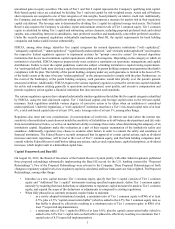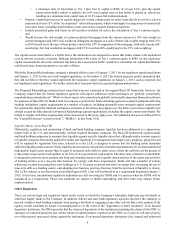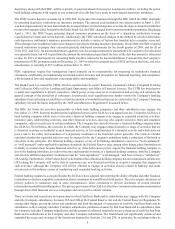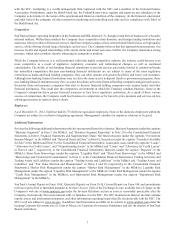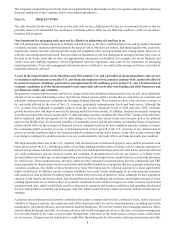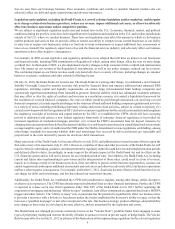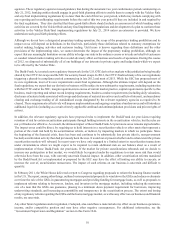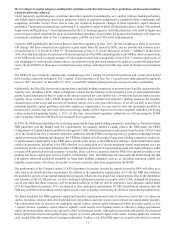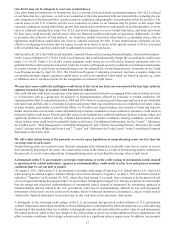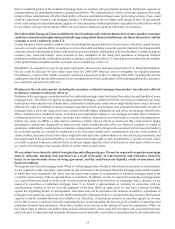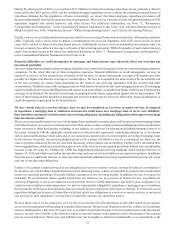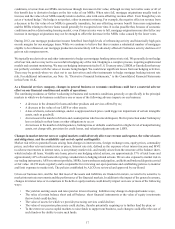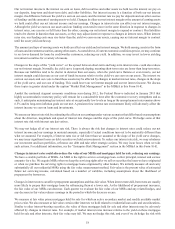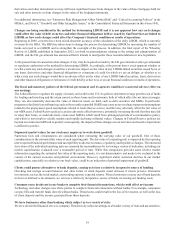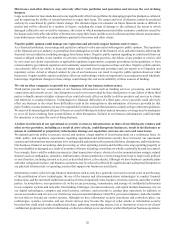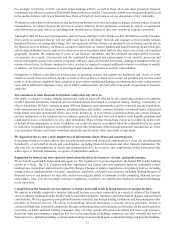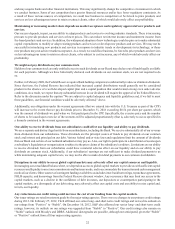SunTrust 2012 Annual Report Download - page 28
Download and view the complete annual report
Please find page 28 of the 2012 SunTrust annual report below. You can navigate through the pages in the report by either clicking on the pages listed below, or by using the keyword search tool below to find specific information within the annual report.12
under CCAR, such approval would not mean that other limitations do not exist on our ability to pay or increase dividends or
repurchase stock.
The need to maintain more capital and greater liquidity than historically has been required could limit our business activities,
including lending, and our ability to expand, either organically or through acquisitions. It could also result in us taking steps
to increase our capital that may be dilutive to shareholders or limit our ability to pay dividends or otherwise return capital to
shareholders. In addition, the new liquidity standards could require us to increase our holdings of highly liquid short-term
investments, thereby reducing our ability to invest in longer-term assets even if more desirable from a balance sheet management
perspective. Moreover, although these new requirements are being phased in over time, U.S. federal banking agencies have
been taking into account expectations regarding the ability of banks to meet these new requirements, including under stressed
conditions, in approving actions that represent uses of capital, such as dividend increases and acquisitions.
Loss of customer deposits and market illiquidity could increase our funding costs.
We rely heavily on bank deposits to be a low cost and stable source of funding for the loans we make. We compete with banks
and other financial services companies for deposits. If our competitors raise the rates they pay on deposits our funding costs
may increase, either because we raise our rates to avoid losing deposits or because we lose deposits and must rely on more
expensive sources of funding. Higher funding costs reduce our net interest margin and net interest income.
We rely on the mortgage secondary market and GSEs for some of our liquidity.
We sell most of the mortgage loans we originate in order to reduce our credit risk and provide funding for additional loans.
We rely on GSEs to purchase loans that meet their conforming loan requirements and on other capital markets investors to
purchase loans that do not meet those requirements–referred to as “nonconforming” loans. Since 2007, investor demand for
nonconforming loans has fallen sharply, increasing credit spreads and reducing the liquidity for those loans. In response to
the reduced liquidity in the capital markets, we may retain more nonconforming loans negatively impacting reserves, or we
may originate less negatively impacting revenue. When we retain a loan not only do we keep the credit risk of the loan but
we also do not receive any sale proceeds that could be used to generate new loans. Continued lack of liquidity could limit our
ability to fund–and thus originate–new mortgage loans, reducing the fees we earn from originating and servicing loans. In
addition, we cannot provide assurance that GSEs will not materially limit their purchases of conforming loans due to capital
constraints or change their criteria for conforming loans (e.g., maximum loan amount or borrower eligibility). As previously
noted, proposals have been presented to reform the housing finance market in the U.S., including the role of the GSEs in the
housing finance market. The extent and timing of any such regulatory reform regarding the housing finance market and the
GSEs, as well as any effect on our business and financial results, are uncertain.
We are subject to credit risk.
When we loan money, commit to loan money or enter into a letter of credit or other contract with a counterparty, we incur
credit risk, which is the risk of losses if our borrowers do not repay their loans or our counterparties fail to perform according
to the terms of their contracts. A number of our products expose us to credit risk, including loans, leases and lending
commitments, derivatives, trading assets, insurance arrangements with respect to such products, and assets held for sale. As
one of the nation's largest lenders, the credit quality of our portfolio can have a significant impact on our earnings. We estimate
and establish reserves for credit risks and credit losses inherent in our credit exposure (including unfunded credit commitments).
This process, which is critical to our financial results and condition, requires difficult, subjective and complex judgments,
including forecasts of economic conditions and how these economic predictions might impair the ability of our borrowers to
repay their loans. As is the case with any such assessments, there is always the chance that we will fail to identify the proper
factors or that we will fail to accurately estimate the impacts of factors that we do identify.
We might underestimate the credit losses inherent in our loan portfolio and have credit losses in excess of the amount reserved.
We might increase the allowance because of changing economic conditions, including falling home prices and higher
unemployment, or other factors such as changes in borrower behavior. As an example, borrowers may discontinue making
payments on their real estate-secured loans if the value of the real estate is less than what they owe, even if they are still
financially able to make the payments.
While we believe that our allowance for credit losses was adequate at December 31, 2012, there is no assurance that it will
be sufficient to cover all incurred credit losses, especially if housing and employment conditions worsen. In the event of
significant deterioration in economic conditions, we may be required to increase reserves in future periods, which would
reduce our earnings. For additional information, see the “Risk Management–Credit Risk Management” and “Critical
Accounting Policies–Allowance for Credit Losses” sections in the MD&A in this Form 10-K.



